AUCTORES
Globalize your Research
Mini Review
*Corresponding Author: Abdul Wahab Alahmari, Radiology Specialist, Ministry of Health, Abha, Kingdom of Saudi Arabia.
Citation: Abdul Wahab Alahmari (2020) The Neuroimaging Documentation of Psychedelic Drugs’ Effect on the Brain: dmt, lsd, Psilocybin, and Ibogaine as Examples: A Mini Review. 5(2): Doi:10.31579/2642-973X/027
Copyright: © 2020 Abdul Wahab Alahmari, this is an open-access article distributed under the terms of The Creative Commons Attribution License, which permits unrestricted use, distribution, and reproduction in any medium, provided the original author and source are credited.
Received: 11 April 2022 | Accepted: 31 May 2022 | Published: 20 June 2022
Keywords: dmt; lsd; psilocybin; ibogaine; neuroimaging; brain effect; addiction
Many psychedelics drugs are praised on social media platforms like YouTube by non-experts or bias documentaries claiming that these drugs have therapeutic effects on addicted patients or clarity of the mind. The aim of this paper is to collect a neuroimaging documentation of these psychedelics’ drugs and their effect on the brain. That can be documented on MRI, CT, or any other imaging modalities.
Psychedelic drugs are used mostly without medical prescription due to its hallucination effect which is desired by many. But there are many who claim that these hallucogenic drugs can help stop addiction or clear the mind. For example, one YouTube channel and podcast on spotify named “Joe Rogan experience” have been mentioned countless times DMT until the show become so associated with psychedelics. As well, on the same show and others they claim that ibogaine will stop addiction. Since this show have been associated with many conspiracy theories and hosted Alex Jones (another conspiracy theorist) many times, they claim that the United States government have banned ibogaine and ibogaine clinics to allow more drug industry which is not accurate since ibogaine damage the purkinje cells in the cerebellum and it cause a large list of side effects including erectile dysfunction. This paper will take four popular psychedelic drugs and evaluate their effectiveness based on the scientific published literature and provide any published neuroimaging evidences of a change in the brain morphology or function.
There is a contra argument about psychedelics where many advocates say these psychedelics are not harmful when these psychedelics are used with small doses like LSD. But a general rule in drugs that dose need to be increased over time to reach euphoria, hallucination, or whatever is the effect of the used drug. Therefore, the dose control argument can’t be used since “under-sensitivity” can developed over time and with more use of the substance and it will lead to overdose eventually. Then the damage can occur due to the overdose.
N, N-dimethyltryptamine (DMT)
Naturally is known as ayahuasca is South America used in rituals and ceremonies. Synthetically is DMT which is mixed with other pharmaceutical materials (i.e. to be activated orally, but it is active alone when administrated intravenous or intramuscular) to make a chemical psychedelic. Both are serotonergic psychedelic and DMT at high doses can cause seizures, respiratory arrest, coma, and serotonin syndrome for patients who use anti-depressants. DMT is dangerous on patients who have schizophrenia. DMT is not addictive, but the user could crave it psychologically. Some users can hurt themselves, while they experience these visual and auditory hallucinations which can see and feel near-death experience (NDE) 1 in their so called “trips”. DMT has the lowest side effects among the four psychedelics mentioned in this paper.
Ayahuasca intake showed alter consciousness under fMRI. The posterior cingulate cortex, precuneus, and medial prefrontal cortex are responsible for default mode network which responsible for self-oriented mental activity. The connection between the posterior cingulate cortex and precuneus were affected (i.e. decrease) after ingesting the ayahuasca appeared on the activity map and compared before and after consumption [2]. see (Fig. 1). In another meta-analysis found in multiple studies deactivation of certain regions in the brains because of using DMT ayahuasca, psilocybin, and LSD users mainly in; amygdala, temporal gyrus, and fusiform gyrus on activation likelihood estimation (ALE) meta-analysis of the fMRI. As well, frontal, parietal, and limbic lobes are activated, but the putamen and anterior cingulate are highly activated. The connectivity of the left hemisphere was disturbed. Specifically, the cingulate cortex and inferior temporal gyrus of the left hemisphere.
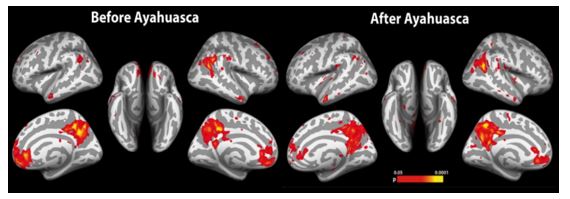
A published study claims to use DMT to treat bipolar depression [3]. Another paper claim to use DMT to treat anxiety and post-traumatic stress disorder (PTSD) [4]. The issue is the first paper is based on a single case and the other paper is based on an experiment on a rat. Furthermore, the effect is not known whether caused by the DMT or by the other material mixed with it which is monoamine oxidase inhibitor (MAOI) which was the shared by other authors [5]. Furthermore, there is a published case report about a case of PTSD after using of DMT [6].
Lysergic acid diethylamide (LSD or ACID)
LSD was first synthesized in 1938 and it was well known in the year 1943 that it can be used as a psychedelic. By the year 1960, it was banned for after been associated with the recreational use. It is a potent serotonergic psychedelic that have been associated with out of body experience (OBE) 7. It is known from 1967 that LSD cause a chromosomal change or damage [8]. Where others found it to be dangerous for pregnant and at high doses respectively [9,10]. The author of the first paper did not make a very disturbing title for the published paper. According to Dicots et al. (1967), the next author in 1971 made the titles of their paper very disturbing and entitled “LSD and genetic damage” and they made a conclusion that LSD does not affect the chromosomes to capture the attention for their papers. All the mentioned responses in their paper to other papers were “negative reports”, “non-confirmed results”, “alleged”, “undetectable”, “we believe”, etc. Their paper has been refuted by a later paper in 1978 and LSD damage was proven and detected at high doses [10]. Then Cornwell et al. (2010) published a paper under the title “the myth of "moral panic": an alternative account of LSD prohibition” claiming that the author of the first paper want to make a moral panic regarding LSD which is not accurate [11]. Furthermore, the author used the word “myth” to regard the finding of that paper as not true which is proven in many papers to be not the case [8,9,10]. This shows that there is a pro-psychedelics movement that disregard any scientific empirical evidence which is similar to what these YouTube channels (i.e. Joe Rogan and other similar streams) are preaching daily. The issue is corn well (2010) did not test any patient, conduct an experiment on patients using LSD, or provide any scientific proves, but it was speaking about how papers like LSD was presented in the media. Furthermore, the author used the same technique that he was criticizing by using a “catchy” or “provocative” title which he did worse than the rest of the papers published about LSD. The author made 26 pages long of rambling about mass control which is the favorite topic for people like Alex Jones and Joe Rogan and other conspiracy theorists.
The effect of LSD on chromosomes is well documented. The effect on the brain by LSD using three imaging techniques which are; arterial spin labeling (ALS), blood oxygen level dependent (BOLD), and magnetoencephalography (MEG). The cerebral blood flow (CBF) increased in the visual cortex, increase primary visual cortex (V1) connectivity profile, decrease visual cortex alpha power, and decrease of connectivity between Para hippocampus and retro splenial cortex see (Fig. 2) which correlate with “ego-dissolution” [12]. There is increased resting state functional connectivity (RSFC) between V1 and other cortical and subcortical regions see (Fig. 3). As well, there is a decreased RSFC between Para hippocampus and retro splenial cortex & the posterior cingulate cortex see (Fig. 4). The RSFC increased between Para hippocampus and the medical prefrontal cortex [12].

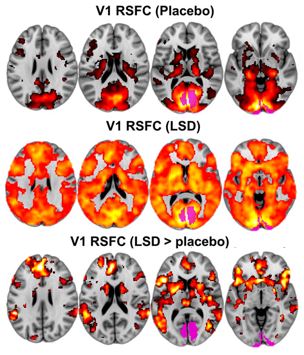
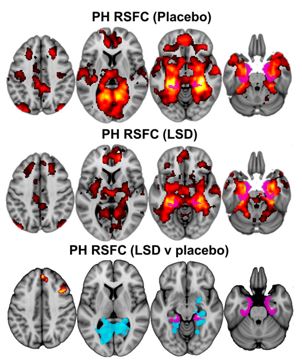
Psilocybin (mushroom)
This psychedelic has been used in rituals and ceremonies for more than 6,000 years and mainly in central America. It is a serotonergic psychedelic like DMT and LSD. This psychedelic mushroom has been tested for potential promising treatment for anxiety, mood disorder, drug addiction & dependency, and depression.
On PET scan, cortical gylocose were increased in patients were given psilocybin compared to patients were given placebo [13]. Both psilocybin and ayahuasca caused decreased of RSFC default-mode network (DMN) on fMRI [2,13].
According to a published study which used a psilocybin to treat depression and monitored by fMRI. A three measurements were taken before and after using psilocybin which are cerebral blood flow (CBF) and blood oxygen-level dependent (BOLD) resting-state functional connectivity (RSFC). The depression symptoms decreased after the treatment and the fMRI showed decreased CBF in the temporal cortex and specially the amygdala see (Fig. 5). As well, the RSFC was decreased in the parahippocampus and prefrontal cortex. The left Heschl’s gyrus, left planum temporale, left precentral gyrus, left superior temporal gyrus, right supramarginal gyrus, left amygdala, and right parietal operculum reached a statistical significance in decreased CBF. The RSFC increased was seen in the default-mode network after the treatment. As well, RSFC increased in ventromedial prefrontal cortex and bilateral inferior lateral parietal cortex. The paper concludes with using psilocybin as “a rest therapeutic for depression” [14]. A high blood flow in the amygdala have been associated with depression [15]. The decrease of depression has been found to be associated with low CBF in the amygdala [14].
The RSFC increased in subgenual anterior cingulate cortex with the posterior cingulate cortex and precuneous after the treatment with psilocybin see (Fig. 6) [14]. The RSFC in the ventromedial prefrontal cortex increased, but did not correlate with depression symptoms see (Fig. 7). The RSFC decreased bilaterally in the parahippocampus, but did not correlate with depression symptoms see (Fig. 8) [14]. The RSFC of the amygdala did not change [14].
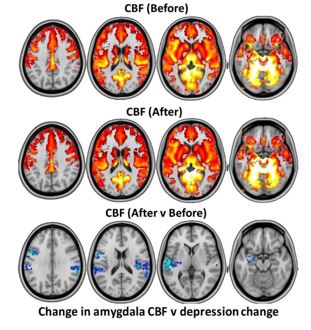
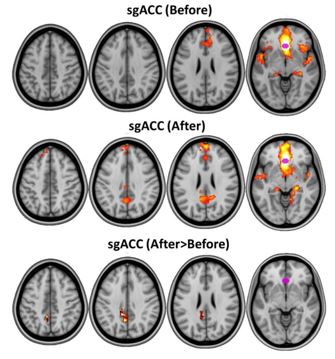

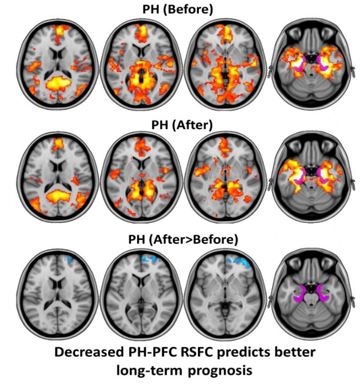
Ibogaine
Chemically is ibogaine and naturally is iboga. It is used to treat addiction and drug dependency. It damages the purkinje cells in the cerebellum on a microscopic level; therefore; the neuroimaging might not be able to show the microscopic damage or change. There is microscopic technique called autoradiography which prepare histology slides then image it in vitro with X-ray. It is called [14]. 2 deoxy glucose method (2-DG) autoradiography which measure local cerebral glucose utilization (LCGU). The glucose level in the brain remains constant under normal physiological circumstances. A published paper measured LCGU in normal rats, ibogaine rats, morphine dependent rats, and morphine dependent & ibogaine treated rats. In ibogaine rats, the ibogaine caused a significant increased LCGU parietal, cingulate, occipital cortices. As well, increased LCGU in the cerebellum. Furthermore, tremorgenic and hallucinogen effect were noticed compared to the control rats. The morphine rats showed a little alteration in the LCGU, but the morphine rats treated with ibogaine showed a global reduction in LCGU in regions as; medial and lateral preoptic areas, cortex of nucleus accumbens, diagonal band nucleus, inferior colliculus, locus coeruleus, and flocculus see (Fig. 9) which does not appear on rats given saline then treated by ibogaine in this experiment [16]. Therefore, these LCGU changes can be linked to the anti-addictive and hallucigenic effect of ibogaine. In an older study, purkinje cells were degenerated in the vermis because of ibogaine [17]. Ibogaine activated astrocyte and microglia which may cause neural injury and degeneration [17].

The effect of these psychedelic is shown not to be therapeutic and based on a weak scientific evidence and did not reach at high level. To be used as a treatment, it needs to reach empirical evidence that is observed in a scientific experiment and passes thru many trials.
It has been shown that DMT treat anxiety and post-traumatic stress disorder claim which is based on a single case and the other paper is based on an experiment on a rat. Furthermore, the effect is not known whether caused by the DMT or by MAOI. There is a case report about DMT user developed PTSD after using DMT [6].
The effect of LSD on chromosomes is well known. Furthermore, a systematic review in 2020 was conducted which found 3,668 papers about LSD. After screening, 43 papers where candidates and further screening lead to excluding 32 papers which are not a clinical trial (i.e. case reports and reviews). The rest 11 papers did not confirm modern standards of clinical trials either without a control group or with a non-randomized control group [18]. This shows that LSD need tested and go thru clinical trials at the highest standards first. The study concludes that only four study out of 11 claim a significant effect in the participant life quality, but no clear alcohol abstinence effect [18]. In addition, LSD can cause death at high doses see (Table 1) [19].
Psilocybin claimed to treat anxiety, mood disorder, drug addiction & dependency, and depression. The CBF map showed decrease of blood flow in the amygdala which has been documented to be associated with depression when the amygdala has a high blood flow. But this is not a sufficient evidence to be a treatment. A paper published by Johns Hopkins team in JAMA claim that psilocybin is “efficacious” treating major depressive disorder (MDD) [20]. while their patients still using their medications! The paper is unclear in their methodology and their CONSORT diagram of participant flow is vague. The paper is unclear how many did not continue the treatment and their sample is 24 participant which is very low. And they depend their conclusion on a personal questionnaire and rater evaluation rather than tangible proves. No placebo was given, short period follows up (four weeks), and specific ethnicity participants all of these do not hold water. After that Johns Hopkins University announced a breakthrough based on a 24 participants study!
Ibogaine used mainly to treat addiction, but it can damage the purkinje cells in the cerebellum and cause erectile dysfunction. The effect of the ibogaine in the cerebellum can’t be documented on a brain CT scan [21, 22]. There are many cases (i.e. a huge number) published about patients who died after using ibogaine.
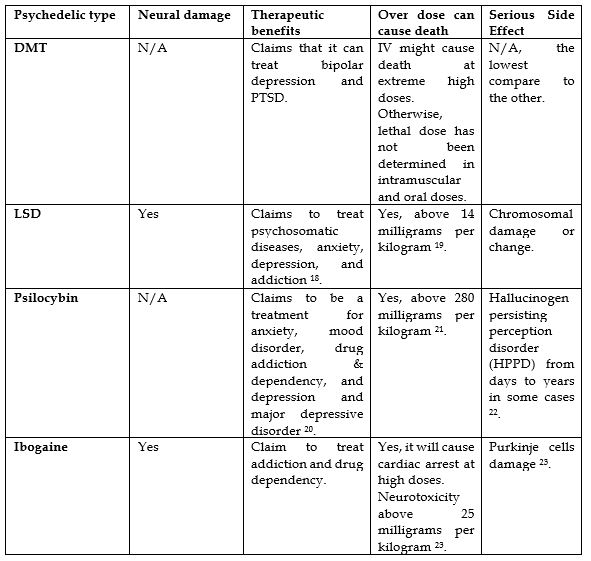
Generally, the activity increased in the cortex and the limbic lobes. Both DMT and psilocybin cause RSFC decreased default-mode network. The reason that DMT and psilocybin has some similarity in their effects, it is probably because they have a similar chemical structure. As well, both LSD and psilocybin cause RSFC decreased in the Para hippocampus see (Table 2).

* no treatment (i.e. at normal circumstances), ** treatment of depression by psilocybin (a.k.a mushroom), *** after treatment of morphine dependent rats with ibogaine.
The suggestion that psychedelics are proven treatments is not accurate at this time. Most of the reviewed papers about the mentioned four psychedelic point to the other direction. Most of the psychedelics in this paper can caused death at high doses. DMT considered the safest and psilocybin as the most promising psychedelic in this paper to treat depression. At this point none of them is a reliable treatment. Due to the legalization of marijuana in the United States, the culture of legalizing substances is a new trend. Pushing for legalizing psychedelics right now is not based on empirical evidence of their healing power, but based on emotional bases to be used for recreational purposes like what is seen in the documentary movie made by Joe Rogan called “DMT: The spirit molecule 2010”. The movie did not show any benefit of DMT except where they claimed to prepare cancer patients for death by giving them DMT. What if the patients had a bad trip and become more anxious from death? Giving DMT to cancer patients to prepare them for death is a weak argument. Furthermore, the documentary asked a mathematician to give his scientific opinion about DMT which shows the bias and lack of credibility. What a mathematician knows about pharmacology, psychology, psychiatry, and neurology? Other treatment should be looked for to treat mental illness like; depression or addiction since a lot of bias can be spotted in psychedelic papers because it became like other polarizing topics such as; abortion or death penalty. As this paper showed many examples of others who ignored the data and preach slogans for political or emotional purposes.
Clearly Auctoresonline and particularly Psychology and Mental Health Care Journal is dedicated to improving health care services for individuals and populations. The editorial boards' ability to efficiently recognize and share the global importance of health literacy with a variety of stakeholders. Auctoresonline publishing platform can be used to facilitate of optimal client-based services and should be added to health care professionals' repertoire of evidence-based health care resources.

Journal of Clinical Cardiology and Cardiovascular Intervention The submission and review process was adequate. However I think that the publication total value should have been enlightened in early fases. Thank you for all.

Journal of Women Health Care and Issues By the present mail, I want to say thank to you and tour colleagues for facilitating my published article. Specially thank you for the peer review process, support from the editorial office. I appreciate positively the quality of your journal.
Journal of Clinical Research and Reports I would be very delighted to submit my testimonial regarding the reviewer board and the editorial office. The reviewer board were accurate and helpful regarding any modifications for my manuscript. And the editorial office were very helpful and supportive in contacting and monitoring with any update and offering help. It was my pleasure to contribute with your promising Journal and I am looking forward for more collaboration.

We would like to thank the Journal of Thoracic Disease and Cardiothoracic Surgery because of the services they provided us for our articles. The peer-review process was done in a very excellent time manner, and the opinions of the reviewers helped us to improve our manuscript further. The editorial office had an outstanding correspondence with us and guided us in many ways. During a hard time of the pandemic that is affecting every one of us tremendously, the editorial office helped us make everything easier for publishing scientific work. Hope for a more scientific relationship with your Journal.

The peer-review process which consisted high quality queries on the paper. I did answer six reviewers’ questions and comments before the paper was accepted. The support from the editorial office is excellent.

Journal of Neuroscience and Neurological Surgery. I had the experience of publishing a research article recently. The whole process was simple from submission to publication. The reviewers made specific and valuable recommendations and corrections that improved the quality of my publication. I strongly recommend this Journal.

Dr. Katarzyna Byczkowska My testimonial covering: "The peer review process is quick and effective. The support from the editorial office is very professional and friendly. Quality of the Clinical Cardiology and Cardiovascular Interventions is scientific and publishes ground-breaking research on cardiology that is useful for other professionals in the field.

Thank you most sincerely, with regard to the support you have given in relation to the reviewing process and the processing of my article entitled "Large Cell Neuroendocrine Carcinoma of The Prostate Gland: A Review and Update" for publication in your esteemed Journal, Journal of Cancer Research and Cellular Therapeutics". The editorial team has been very supportive.

Testimony of Journal of Clinical Otorhinolaryngology: work with your Reviews has been a educational and constructive experience. The editorial office were very helpful and supportive. It was a pleasure to contribute to your Journal.

Dr. Bernard Terkimbi Utoo, I am happy to publish my scientific work in Journal of Women Health Care and Issues (JWHCI). The manuscript submission was seamless and peer review process was top notch. I was amazed that 4 reviewers worked on the manuscript which made it a highly technical, standard and excellent quality paper. I appreciate the format and consideration for the APC as well as the speed of publication. It is my pleasure to continue with this scientific relationship with the esteem JWHCI.

This is an acknowledgment for peer reviewers, editorial board of Journal of Clinical Research and Reports. They show a lot of consideration for us as publishers for our research article “Evaluation of the different factors associated with side effects of COVID-19 vaccination on medical students, Mutah university, Al-Karak, Jordan”, in a very professional and easy way. This journal is one of outstanding medical journal.
Dear Hao Jiang, to Journal of Nutrition and Food Processing We greatly appreciate the efficient, professional and rapid processing of our paper by your team. If there is anything else we should do, please do not hesitate to let us know. On behalf of my co-authors, we would like to express our great appreciation to editor and reviewers.

As an author who has recently published in the journal "Brain and Neurological Disorders". I am delighted to provide a testimonial on the peer review process, editorial office support, and the overall quality of the journal. The peer review process at Brain and Neurological Disorders is rigorous and meticulous, ensuring that only high-quality, evidence-based research is published. The reviewers are experts in their fields, and their comments and suggestions were constructive and helped improve the quality of my manuscript. The review process was timely and efficient, with clear communication from the editorial office at each stage. The support from the editorial office was exceptional throughout the entire process. The editorial staff was responsive, professional, and always willing to help. They provided valuable guidance on formatting, structure, and ethical considerations, making the submission process seamless. Moreover, they kept me informed about the status of my manuscript and provided timely updates, which made the process less stressful. The journal Brain and Neurological Disorders is of the highest quality, with a strong focus on publishing cutting-edge research in the field of neurology. The articles published in this journal are well-researched, rigorously peer-reviewed, and written by experts in the field. The journal maintains high standards, ensuring that readers are provided with the most up-to-date and reliable information on brain and neurological disorders. In conclusion, I had a wonderful experience publishing in Brain and Neurological Disorders. The peer review process was thorough, the editorial office provided exceptional support, and the journal's quality is second to none. I would highly recommend this journal to any researcher working in the field of neurology and brain disorders.

Dear Agrippa Hilda, Journal of Neuroscience and Neurological Surgery, Editorial Coordinator, I trust this message finds you well. I want to extend my appreciation for considering my article for publication in your esteemed journal. I am pleased to provide a testimonial regarding the peer review process and the support received from your editorial office. The peer review process for my paper was carried out in a highly professional and thorough manner. The feedback and comments provided by the authors were constructive and very useful in improving the quality of the manuscript. This rigorous assessment process undoubtedly contributes to the high standards maintained by your journal.

International Journal of Clinical Case Reports and Reviews. I strongly recommend to consider submitting your work to this high-quality journal. The support and availability of the Editorial staff is outstanding and the review process was both efficient and rigorous.

Thank you very much for publishing my Research Article titled “Comparing Treatment Outcome Of Allergic Rhinitis Patients After Using Fluticasone Nasal Spray And Nasal Douching" in the Journal of Clinical Otorhinolaryngology. As Medical Professionals we are immensely benefited from study of various informative Articles and Papers published in this high quality Journal. I look forward to enriching my knowledge by regular study of the Journal and contribute my future work in the field of ENT through the Journal for use by the medical fraternity. The support from the Editorial office was excellent and very prompt. I also welcome the comments received from the readers of my Research Article.

Dear Erica Kelsey, Editorial Coordinator of Cancer Research and Cellular Therapeutics Our team is very satisfied with the processing of our paper by your journal. That was fast, efficient, rigorous, but without unnecessary complications. We appreciated the very short time between the submission of the paper and its publication on line on your site.

I am very glad to say that the peer review process is very successful and fast and support from the Editorial Office. Therefore, I would like to continue our scientific relationship for a long time. And I especially thank you for your kindly attention towards my article. Have a good day!

"We recently published an article entitled “Influence of beta-Cyclodextrins upon the Degradation of Carbofuran Derivatives under Alkaline Conditions" in the Journal of “Pesticides and Biofertilizers” to show that the cyclodextrins protect the carbamates increasing their half-life time in the presence of basic conditions This will be very helpful to understand carbofuran behaviour in the analytical, agro-environmental and food areas. We greatly appreciated the interaction with the editor and the editorial team; we were particularly well accompanied during the course of the revision process, since all various steps towards publication were short and without delay".

I would like to express my gratitude towards you process of article review and submission. I found this to be very fair and expedient. Your follow up has been excellent. I have many publications in national and international journal and your process has been one of the best so far. Keep up the great work.

We are grateful for this opportunity to provide a glowing recommendation to the Journal of Psychiatry and Psychotherapy. We found that the editorial team were very supportive, helpful, kept us abreast of timelines and over all very professional in nature. The peer review process was rigorous, efficient and constructive that really enhanced our article submission. The experience with this journal remains one of our best ever and we look forward to providing future submissions in the near future.

I am very pleased to serve as EBM of the journal, I hope many years of my experience in stem cells can help the journal from one way or another. As we know, stem cells hold great potential for regenerative medicine, which are mostly used to promote the repair response of diseased, dysfunctional or injured tissue using stem cells or their derivatives. I think Stem Cell Research and Therapeutics International is a great platform to publish and share the understanding towards the biology and translational or clinical application of stem cells.

I would like to give my testimony in the support I have got by the peer review process and to support the editorial office where they were of asset to support young author like me to be encouraged to publish their work in your respected journal and globalize and share knowledge across the globe. I really give my great gratitude to your journal and the peer review including the editorial office.

I am delighted to publish our manuscript entitled "A Perspective on Cocaine Induced Stroke - Its Mechanisms and Management" in the Journal of Neuroscience and Neurological Surgery. The peer review process, support from the editorial office, and quality of the journal are excellent. The manuscripts published are of high quality and of excellent scientific value. I recommend this journal very much to colleagues.

Dr.Tania Muñoz, My experience as researcher and author of a review article in The Journal Clinical Cardiology and Interventions has been very enriching and stimulating. The editorial team is excellent, performs its work with absolute responsibility and delivery. They are proactive, dynamic and receptive to all proposals. Supporting at all times the vast universe of authors who choose them as an option for publication. The team of review specialists, members of the editorial board, are brilliant professionals, with remarkable performance in medical research and scientific methodology. Together they form a frontline team that consolidates the JCCI as a magnificent option for the publication and review of high-level medical articles and broad collective interest. I am honored to be able to share my review article and open to receive all your comments.

“The peer review process of JPMHC is quick and effective. Authors are benefited by good and professional reviewers with huge experience in the field of psychology and mental health. The support from the editorial office is very professional. People to contact to are friendly and happy to help and assist any query authors might have. Quality of the Journal is scientific and publishes ground-breaking research on mental health that is useful for other professionals in the field”.

Dear editorial department: On behalf of our team, I hereby certify the reliability and superiority of the International Journal of Clinical Case Reports and Reviews in the peer review process, editorial support, and journal quality. Firstly, the peer review process of the International Journal of Clinical Case Reports and Reviews is rigorous, fair, transparent, fast, and of high quality. The editorial department invites experts from relevant fields as anonymous reviewers to review all submitted manuscripts. These experts have rich academic backgrounds and experience, and can accurately evaluate the academic quality, originality, and suitability of manuscripts. The editorial department is committed to ensuring the rigor of the peer review process, while also making every effort to ensure a fast review cycle to meet the needs of authors and the academic community. Secondly, the editorial team of the International Journal of Clinical Case Reports and Reviews is composed of a group of senior scholars and professionals with rich experience and professional knowledge in related fields. The editorial department is committed to assisting authors in improving their manuscripts, ensuring their academic accuracy, clarity, and completeness. Editors actively collaborate with authors, providing useful suggestions and feedback to promote the improvement and development of the manuscript. We believe that the support of the editorial department is one of the key factors in ensuring the quality of the journal. Finally, the International Journal of Clinical Case Reports and Reviews is renowned for its high- quality articles and strict academic standards. The editorial department is committed to publishing innovative and academically valuable research results to promote the development and progress of related fields. The International Journal of Clinical Case Reports and Reviews is reasonably priced and ensures excellent service and quality ratio, allowing authors to obtain high-level academic publishing opportunities in an affordable manner. I hereby solemnly declare that the International Journal of Clinical Case Reports and Reviews has a high level of credibility and superiority in terms of peer review process, editorial support, reasonable fees, and journal quality. Sincerely, Rui Tao.

Clinical Cardiology and Cardiovascular Interventions I testity the covering of the peer review process, support from the editorial office, and quality of the journal.

Clinical Cardiology and Cardiovascular Interventions, we deeply appreciate the interest shown in our work and its publication. It has been a true pleasure to collaborate with you. The peer review process, as well as the support provided by the editorial office, have been exceptional, and the quality of the journal is very high, which was a determining factor in our decision to publish with you.
The peer reviewers process is quick and effective, the supports from editorial office is excellent, the quality of journal is high. I would like to collabroate with Internatioanl journal of Clinical Case Reports and Reviews journal clinically in the future time.

Clinical Cardiology and Cardiovascular Interventions, I would like to express my sincerest gratitude for the trust placed in our team for the publication in your journal. It has been a true pleasure to collaborate with you on this project. I am pleased to inform you that both the peer review process and the attention from the editorial coordination have been excellent. Your team has worked with dedication and professionalism to ensure that your publication meets the highest standards of quality. We are confident that this collaboration will result in mutual success, and we are eager to see the fruits of this shared effort.

Dear Dr. Jessica Magne, Editorial Coordinator 0f Clinical Cardiology and Cardiovascular Interventions, I hope this message finds you well. I want to express my utmost gratitude for your excellent work and for the dedication and speed in the publication process of my article titled "Navigating Innovation: Qualitative Insights on Using Technology for Health Education in Acute Coronary Syndrome Patients." I am very satisfied with the peer review process, the support from the editorial office, and the quality of the journal. I hope we can maintain our scientific relationship in the long term.
Dear Monica Gissare, - Editorial Coordinator of Nutrition and Food Processing. ¨My testimony with you is truly professional, with a positive response regarding the follow-up of the article and its review, you took into account my qualities and the importance of the topic¨.

Dear Dr. Jessica Magne, Editorial Coordinator 0f Clinical Cardiology and Cardiovascular Interventions, The review process for the article “The Handling of Anti-aggregants and Anticoagulants in the Oncologic Heart Patient Submitted to Surgery” was extremely rigorous and detailed. From the initial submission to the final acceptance, the editorial team at the “Journal of Clinical Cardiology and Cardiovascular Interventions” demonstrated a high level of professionalism and dedication. The reviewers provided constructive and detailed feedback, which was essential for improving the quality of our work. Communication was always clear and efficient, ensuring that all our questions were promptly addressed. The quality of the “Journal of Clinical Cardiology and Cardiovascular Interventions” is undeniable. It is a peer-reviewed, open-access publication dedicated exclusively to disseminating high-quality research in the field of clinical cardiology and cardiovascular interventions. The journal's impact factor is currently under evaluation, and it is indexed in reputable databases, which further reinforces its credibility and relevance in the scientific field. I highly recommend this journal to researchers looking for a reputable platform to publish their studies.

Dear Editorial Coordinator of the Journal of Nutrition and Food Processing! "I would like to thank the Journal of Nutrition and Food Processing for including and publishing my article. The peer review process was very quick, movement and precise. The Editorial Board has done an extremely conscientious job with much help, valuable comments and advices. I find the journal very valuable from a professional point of view, thank you very much for allowing me to be part of it and I would like to participate in the future!”

Dealing with The Journal of Neurology and Neurological Surgery was very smooth and comprehensive. The office staff took time to address my needs and the response from editors and the office was prompt and fair. I certainly hope to publish with this journal again.Their professionalism is apparent and more than satisfactory. Susan Weiner

My Testimonial Covering as fellowing: Lin-Show Chin. The peer reviewers process is quick and effective, the supports from editorial office is excellent, the quality of journal is high. I would like to collabroate with Internatioanl journal of Clinical Case Reports and Reviews.

My experience publishing in Psychology and Mental Health Care was exceptional. The peer review process was rigorous and constructive, with reviewers providing valuable insights that helped enhance the quality of our work. The editorial team was highly supportive and responsive, making the submission process smooth and efficient. The journal's commitment to high standards and academic rigor makes it a respected platform for quality research. I am grateful for the opportunity to publish in such a reputable journal.
My experience publishing in International Journal of Clinical Case Reports and Reviews was exceptional. I Come forth to Provide a Testimonial Covering the Peer Review Process and the editorial office for the Professional and Impartial Evaluation of the Manuscript.
